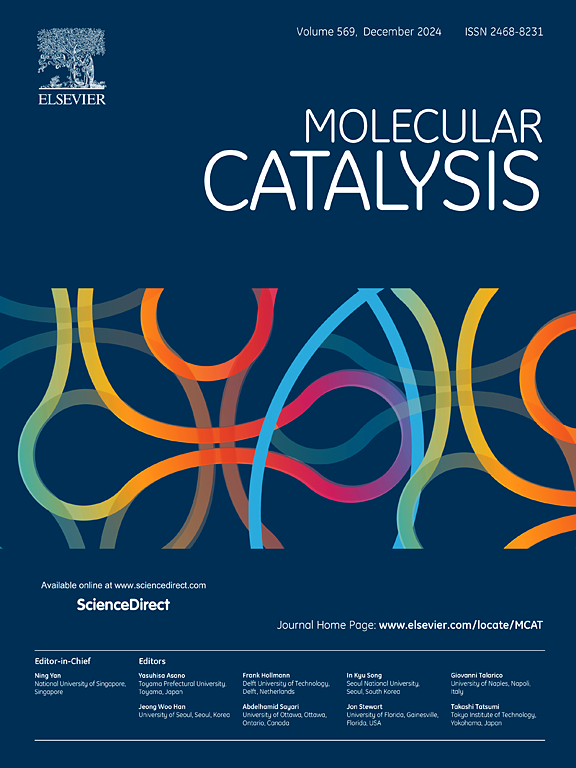层状AlOOH支撑的超低负载Ni-Pt上糠醛加氢和环戊酮环重排
IF 3.9
2区 化学
Q2 CHEMISTRY, PHYSICAL
引用次数: 0
摘要
构建高效、廉价的糠醛制环戊酮金属催化剂对生物质的利用和精细化学品的合成具有重要意义。金属位和酸位的协同作用是羰基加氢和环重排的关键因素。在此基础上,合成了AlOOH,以支撑贱金属镍(1%)和超低负荷铂(0.1%),高效、选择性地将CPO从FFL完全转化为普通Al2O3载体是难以实现的。通过红外光谱表征和h2 -程序升温还原,Ni1Pt0.1/AlOOH对FFL的羟基有较强的吸附,金属间的紧密结合促进了整体活性位点的还原。与Ni1/AlOOH和Pt0.1/AlOOH相比,添加0.1 wt %的Pt可以使Ni在加氢过程中发挥与Pt相同的作用,同时成本更低。层状AlOOH具有比普通Al2O3更高的活性。层状氢氧化物的结构和水作为溶剂的使用促进了醛基的氢化和环的排列。在优化条件(150°C, 40 bar H2, 6 h)下,Ni1Pt0.1/AlOOH对CPO的选择性达到98%。同位素标记实验表明,氢氢键的断裂同时影响氢化和重排,而水中氢氧键的断裂只影响重排。本研究不仅开发了一种超低负荷双金属催化剂,用于FFL高效加氢和环重排成CPO,而且还探索了贵金属与贱金属、金属位与酸位之间的协同作用。本文章由计算机程序翻译,如有差异,请以英文原文为准。
Hydrogenation and Ring-rearrangement of Furfural to Cyclopentanone over Ultralow-loading Ni-Pt Supported on Layered AlOOH
Constructing efficient and inexpensive metal catalysts to produce cyclopentanone (CPO) from furfural (FFL) is of great significance for the utilization of biomass and synthesis of fine chemicals. The synergy of metal site and acid site is a key factor for hydrogenation of carbonyl and ring-rearrangement. Herein, AlOOH is synthesized to support base metal, nickel (1 %), and ultralow-loading platinum (0.1 %) for the complete conversion of CPO from FFL efficiently and selectively, which is difficult to achieve with common Al2O3 as support. Through infrared spectroscopy characterization and H2-temperature-programmed reduction, Ni1Pt0.1/AlOOH has stronger adsorption of the hydroxyl group of FFL and tight bonding between metals promotes the reduction of the overall active sites. Comparison to Ni1/AlOOH and Pt0.1/AlOOH individually, the addition of 0.1 wt % Pt enables Ni to play the same role as Pt in hydrogenation while being cheaper. Layered AlOOH has higher activity than common Al2O3. The structure of layered hydroxides and the use of water as a solvent promote the hydrogenation of aldehyde group and ring-arrangement. Under the optimized conditions (150 °C, 40 bar of H2, and 6 h), Ni1Pt0.1/AlOOH achieves 98 % selectivity for CPO. Isotope labeling experiments revealed that H-H bond cleavage affects both hydrogenation and rearrangement, while O![]() H bond cleavage in water impacts only rearrangement. This study not only developed an ultralow-loading bimetal catalyst for the efficient hydrogenation and ring-rearrangement of FFL to CPO, but also explored the synergy between noble metals and base metals, as well as between metal sites and acid sites.
H bond cleavage in water impacts only rearrangement. This study not only developed an ultralow-loading bimetal catalyst for the efficient hydrogenation and ring-rearrangement of FFL to CPO, but also explored the synergy between noble metals and base metals, as well as between metal sites and acid sites.
求助全文
通过发布文献求助,成功后即可免费获取论文全文。
去求助
来源期刊

Molecular Catalysis
Chemical Engineering-Process Chemistry and Technology
CiteScore
6.90
自引率
10.90%
发文量
700
审稿时长
40 days
期刊介绍:
Molecular Catalysis publishes full papers that are original, rigorous, and scholarly contributions examining the molecular and atomic aspects of catalytic activation and reaction mechanisms. The fields covered are:
Heterogeneous catalysis including immobilized molecular catalysts
Homogeneous catalysis including organocatalysis, organometallic catalysis and biocatalysis
Photo- and electrochemistry
Theoretical aspects of catalysis analyzed by computational methods
 求助内容:
求助内容: 应助结果提醒方式:
应助结果提醒方式:


